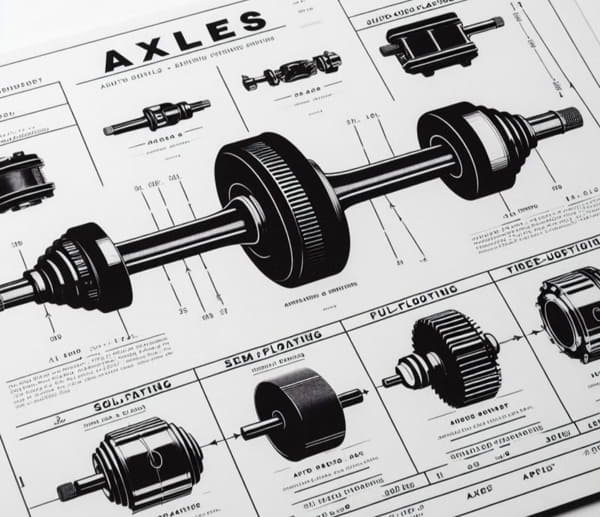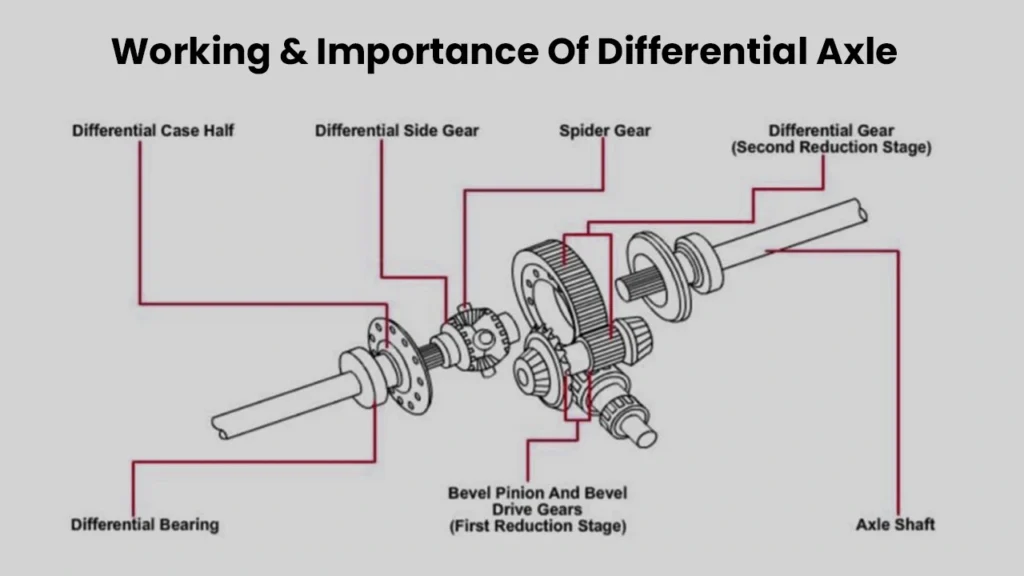Are you a car enthusiast and need to know how many axles a car has? Well, axles act as a primary component in the movement of the car wheels. In automobiles, an axle is a rod that connects the vehicle’s wheels, bears the car’s weight, and transfers power from the engine to the wheels. Axles contribute to the car’s overall Performance, so automobile manufacturers emphasize a quality axle with great functionality.
Studies show that axle design directly impacts not only vehicle handling but also fuel efficiency and longevity. Whether you drive a compact sedan or a heavy-duty truck, understanding the significance of this component can give you a whole new appreciation for what goes on under the hood.
What is the Axle of a Car?

Unfortunately, not many people know what a car axle is. Think of a 4-wheeled car and look at the front two wheels; the central steel rod that connects them and acts as a bridge is called an axle. Similarly, a single axle connects the rear two wheels of the car. So, we got an early observation that a 4-wheel car typically has 2 axles.
How Does an Axle Work?
Consider you start a car, and the engine got ignition. With this, the engine shaft starts moving, giving the motor a rotational force. This rotational force is transmitted to the engine’s crankshaft, further connected with numerous components, such as a traditional gearbox or a continuously variable transmission (CVT) in some modern vehicles.
However, there are also multiple mechanical parts involved in this connection. Now, this Axle receives the power and provides the power to the car’s wheels that, as a result, move the car.
So, the Axle of a car is an important component that establishes the power transmission linkage from the engine to the wheels.
Importance of an Axle

Besides transmitting the power to the wheels, axles are very important to reliability, Performance, and safety. If you are looking out for the significance of axles, we have short-listed some of the points for you:
Synchronization in Wheel Movement:
As mentioned above, axles are long cylindrical rods that help in the movement of the wheels. Diving deep into the axle mechanics, they are connected to the wheel’s center and extend to the car’s differential. Such connection enables the smooth and synchronized movement of the wheels without wobbling. They make the wheel move at a synchronized speed that makes the driving experience smooth.
Handling of the Car:
When you push the accelerator of the car or rotate the steering, or apply brakes, axles act as a primary component in ensuring the effectiveness of the car. They support the car’s weight as they are sturdy components and divide the power to the wheels. This ensures very smooth and reliable handling of the car.
Increasing the Performance of a Vehicle:
Everyone wants a reliable family car with excellent Performance. An axle of bad quality affects the vehicle’s Performance and destroys the wheel alignment and wheel balancing. A good quality axle improves the quality of the vehicle by providing a balance of power, enhancing the suspension and braking system, and reducing the risk of uneven tire wear.
Support Weight:
The axle is the car’s workhorse for weight support. Made of tough steel, it acts like a beam, distributing the car’s weight (including passengers and cargo) evenly across its surface. The suspension system acts as a partner, absorbing bumps and distributing the load further. Wheel hubs connect the axle to the wheels, ensuring weight transfer for the tires to handle.
Axles come in various strengths; thicker axles are used in heavier vehicles like trucks. Front-wheel drive axles even play a steering role. In short, the axle is a crucial component for supporting your good looking car’s weight and ensuring a smooth ride.
Enhancing Fuel Efficiency:
Well-designed axles can help you save gas. They spread power smartly and cut friction in the car’s guts, so the engine doesn’t work too hard. For instance, small cars have light axles and electric ones use fancy E-Axles—both tricks mean less energy wasted. This makes axles a hidden hero in the quest for greener, more efficient driving.
3 Main Types of Axles
In simple words, a car has two basic types of axles. A dead axle is used to put up with the vehicle’s weight, and a live axle is connected to the wheels and responsible for the movement of the wheels. These two axles are connected by a joint known as a constant velocity joint.
In addition to that, the commonly termed types of axles are:
- Front Axle
- Rear Axle
- Stub Axle
Let’s explore each one of these separately:
1. Front Axle
As the name suggested, front axles are installed at the front part of the vehicle. They are responsible for assisting in steering. They also function to process the shocks generated by uneven or bumpy roads.
Front axles are made from carbon steel or nickel steel, which ensures that the Axle is strong and hard. For people loving adventure and off-road driving, your car should have a sturdy front axle to handle the obstacles on the way.
There are mainly four parts of the front axle that are beam, swivel pin, track rod, and stub axle. The front axle can either be a dead axle or a live axle.
2. Rear Axle
As you have imagined, these axles are located at the rear or back side of the car. Rear axles are mainly focused on delivering power to vehicles, and they normally fall in the category of live axles, as mentioned above. They come in two halves, known as half shafts, which are connected by the differential of the vehicle.
- Semi-floating Axle: These axles are used for cars, SUVs, and mid-size trucks. This axle connects the wheel to the flange located on the outer side of the axle shaft. It has two bearings. One supports the axle shaft and the second goes to the axle casing.
- Full-floating Axle: This type of axle also contains two bearings and these axles are commonly used in larger trucks that are used to carry huge loads and go through rugged roads. Unlike the semi-floating axle, which needs to be larger than the other options for producing the same torque, the full-floating axle effectively floats in place and transmits torque.
- Three-Quarter Floating Axle: It provides better road stability and ensures a smooth driving experience. It is, however, more complex than the full-floating Axle, but it maintains the wheel alignment and is reliable.
3. Stub Axle
A stub axle is another type of Axle found in cars with rear-wheel drive, and it is attached to the vehicle’s front wheels, with kingpins connecting stub axles to the front axle. Depending on their configuration, they can be divided into four categories:
- Elliot: Using a kingpin, cotter, or yoke, this type of sub-axle is attached to the front axle.
- Reverse Elliot: As the name elaborates, this sub-axle has the opposite or reversed arrangement of the standard Elliot sub-axle configuration.
- Lamoine: The Lamoine stub axle has an L-shaped spindle instead of a yoke type.
- Lamoine Reverse: Compared to the standard Lamoine, it has a reversed arrangement than the Lamoine configuration.
Which Type of Axle Does My Car Have?
Different cars are equipped with different axles based on the vehicle’s weight, usage, and other features.
Sedans
Mostly, the front axle setup is installed in sedan cars. This is evident because the front axle is designed to prioritize a smooth and comfortable driving experience, which is why most sedan cars come equipped with it.
Consider why you chose to buy a sedan car. Certainly, it’s for the comfort, fuel efficiency, and the front axle setup that delivers these benefits. In this configuration, the rear wheels follow the movement of the front wheels.
SUVs
SUVs use the rear axle setup. This setup provides a balance between the weight of the vehicle and its stability.
Looking for the answer to how many axles an SUV has? In some cases, an SUV can have more than two axles.
Truck
If you drive a truck, it is confirmed that it is installed with the rear axle type or four-wheel drive axle setup. These types of axles help maintain a smooth experience while the truck is loaded and moving through rough paths. Specifically, a full floating type of axle setup is installed on the trucks.
Off-road Vehicles
A specialized axle setup is installed on these off-road or 4-wheel drive vehicles. Since these cars have to go through bumpy roads and challenging tracks, a specialized axle setup is installed that ensures durability, reliability, and safety.
Also Read: 8 Reliable Ford Models You Should Not Hesitate To Buy!
This setup involves two axles providing torque to four axle ends. Such a setup enhances traction in the situation and maintains a balance of power transmission between the vehicle’s wheels. With reference to the Truck Locator, different 4-wheel drive vehicles have different axle configurations depending on the weight.
Electric Vehicle
As you know, EVs have revolutionized the automobile industry. Similarly, they have an axle setup that is unique and different from other vehicles. This axle setup is called E-Axle, in which the axles run on electric power. E-Axle mainly consists of a gearbox, a motor and an inverter. It is less than half the size of the conventional transmission engine and is capable of producing the same amount of power.
Whether you drive an EV or hybrid car, a front axle or rear E-Axle can be installed on the car that can provide effective torque through the battery’s electric power.
Four-Wheel Drive and All-Wheel Drive Cars
Four-wheel drive (4WD) and all-wheel drive (AWD) rigs both rock two axles—front and back—to push all four tires, beating basic 2WD grip. 4WD stuff, think Jeep Wrangler or Toyota 4Runner, uses live axles hooked to a transfer case splitting torque dead even—50/50—when you flip it on.
Part-time 4WD locks the driveshafts tight, often with low gears (say 2.72:1) for crawling off-road at about 5 mph. Big 4WD trucks like the Ford F-150 have full-floating axles hauling around 3,000–4,000 lbs each, boosting traction maybe 50% over 2WD if diffs lock. Solid axles rule here, but the ride’s rougher on the streets.
AWD rides—Subaru’s Symmetrical AWD or Audi’s Quattro—run two axles too, but with a center diff or clutch tweaking torque from 60/40 to 90/10 based on road slip, without any driver fuss. AWD can be full-time (always powering all wheels, e.g., Subaru’s Symmetrical AWD) or part-time (switching from 2WD to 4WD when traction is needed).
Subaru might fling 70% torque rearward when it’s slick, while Audi’s torque-vectoring bumps corner grip 15%. AWD systems add approximately 200–300 lbs to the vehicle’s weight, reducing fuel efficiency by 1–2 mpg compared to 2WD versions. AWD axles are typically lighter semi-floating designs (1–1.5 inches in diameter) paired with independent suspension for better ride quality, unlike the thicker (1.5–2 inches) 4WD axles built for off-road stress. Some AWD locks diffs for even power at low speed, maxing traction out.
4WD owns off-road and heavy jobs; AWD shines for street ease and wet weather with computer magic running smoothly.
How Much Axle Replacement Costs?

Replacing an axle might not be something we think about every day, but when the time comes, it’s good to know what to expect. On average, swapping out a single axle can set you back anywhere from $300 to $1,500, depending on your vehicle and how long the job takes. The parts themselves usually run between $760 and $1,030, while labor adds another $170 to $180.
Now, here’s the catch – replacing just one axle takes about 1.5 to 3 hours, but if you’re looking to replace all four, you’re looking at a hefty 12-hour job. And yes, that means more labor costs on top of the parts! But don’t worry – you don’t always need to replace all of them. Sometimes, replacing just one is enough to get your car back on the road.
The good news is you don’t have to replace all four axles unless you really need to. That said, it’s not always necessary to replace all four axles. If only one needs replacement, you can stick to that. Moreover, CV axles often last the lifespan of the car.
Some factors that affect the cost include:
Hand-Picked Content: How To Jump Start A Prius Using Jumper Cables?
Vehicle Type:
The cost varies for different types of vehicles, such as larger vehicles & trucks having higher prices because of size and components than the other cars. Now, manufacturers are moving towards reliable, durable cars requiring less maintenance.
Axle Types:
There are different kinds of axles in terms of complexity. When axles have features like limited slip differentials or electronic components, the cost of replacing them tends to be higher because they have intricate designs and require specialized parts.
Labor Costs:
Labor costs can have a significant impact as they vary with the location and the experience of the labor. The per-hour labor cost likely falls between $100 and $150 per hour.
OEM vs. Aftermarket Parts:
When it comes to deciding between original equipment manufacturer (OEM) parts and aftermarket alternatives, the cost factor comes into play. OEM parts usually come with a price tag. They provide better compatibility and quality assurance. On the other hand, aftermarket parts can be more affordable. Their quality and fit may vary.
Conclusion
Axles play a primary role in the Performance of the cars, and they ensure a comfortable driving experience. There are various axle configurations, and different vehicles have different configurations depending on some features and facts. So, ensure that your car axle is of good quality and have a safe journey ahead.
FAQs
- Does a car have 2 or 4 axles?
Most vehicles—like sedans or SUVs—have 2 axles, front and back, for four wheels, but big trucks or off-road beasts might pack 4 or more for weight and grip. - How many axles does a 4-wheel drive car have?
Usually 2—both live, pumping power to all tires, great for rough ground—unless it’s some giant multi-axle ride. - What is a 4-axle car?
That’s a four-axle beast, mostly trucks, not regular cars; each axle holds wheels (sometimes doubles) for heavy loads and balance. - How can I tell how many axles my car has?
Peek underneath—count the rods linking wheels side-to-side; 4-wheelers usually have 2, and bigger ones have extras.
